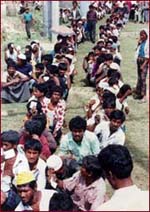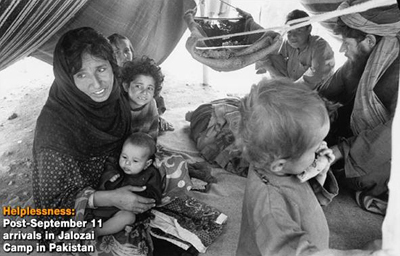dept | resources | glossary | credits | feedback | help | search |
|||||||||||||||||||||||
 |
|||||||||||||||||||||||

|
|||||||||||||||||||||||
 |
|||||||||||||||||||||||
| The Harriet and Robert Heilbrunn Department of Population and Family Health |
|||||||||||||||||||||||
 |
|||||||||||||||||||||||
| intro | definitions | international legal instruments | basic facts | standard responses | major actors | conclusion | exam |
|||||||||||||||||||||||
Basic facts about forced migrants in the world today In this section
you will learn how many and who are current How many forced migrants are there?Few organizations, policy bodies or governments agree on the actual number of forced migrants throughout the world. Because of both political and logistical impediments an accurate, global demographic profile of displaced people is very difficult to establish. The United Nations High Commissioner for Refugees (UNHCR) and the Internal Displacement Monitoring Centre (IDMC) are good sources of data on forced migrants. According to the UNHCR report on 2007 Global Trends:
According to the IDMC the total number of conflict-related internally displaced persons throughout the world (Dec 2008) is 26.0 million.
SOURCE: U.S. Committee for Refugees (USCR) Who are the refugees?Currently, an estimated 44 percent of refugees and asylum-seekers children below the age of 18. The percentage of children compared with the overall refugee population ranges from 57 percent in Central Africa to 20 percent in Central and Eastern Europe. Refugees above 60 years of age constitute more than 15 percent of the refugee population in Eastern Europe and the Balkans, whereas in Africa they generally represent less than 5 percent of the refugee population. Women and girls, i.e. females of all ages, constitute 47 percent of the refugee population and 50 percent of IDPs. It is sometimes suggested that refugee / displaced populations are disproportionately female; however, for the most part, displaced populations reflect a demographic profile similar to the non-displaced in the same region. Exceptions do occur, for example, a high number of males in a camp where families have sent boys to avoid their being recruited into warfare.
Leading causes of mortality among forced migrantsDiarrhea: Epidemics of severe diarrheal disease are common among refugee populations. The crowded conditions of refugee camps are conducive to the rapid spread of diarrheal disease from inadequate sanitation systems that lead to fecal contamination of water sources. Diarrhea can be caused by several pathogens and health disorders, but is particularly of concern in emergencies when associated with epidemic prone diseases like Cholera, Dysentery and Typhoid Fever. Acute respiratory infection: ARIs are consistently a leading cause of mortality among refugee populations. The conditions that are common in refugee settlements such as: crowding, poor ventilation, inadequate shelter, and prolonged exposure to the elements, are common risk factors for ARIs and associated death and illness. Measles: Measles is a highly contagious infectious disease caused by Morbillovirus, common among children but also seen in the nonimmune of any age, in which the virus enters the respiratory tract and multiplies, spreading throughout the body. Outbreaks of measles in refugee camps is common and is one of the leading causes of death in refugee children where immunization coverage is low and high rates of malnutrition and vitamin A deficiency contribute to the deadliness of the disease. Malaria: Malaria is parasitic disease caused in humans by protozoans and transmitted by the bite of an infected female mosquito. Malaria has caused high rates of mortality in refugee camps located in malaria endemic regions of the world. The severity of these outbreaks has been exacerbated by the rapid drug-resistance developed by this parasite. War related injury/trauma: In recent wars, civilians have become major targets of war-related violence. In settings where the diseases mentioned above are not endemic and where health care and population health status prior to conflict is relatively good (i.e. Bosnia 1994) the leading cause of mortality among affected populations have been the injuries/traumas that resulted from war-related violence. Maternal Causes: Approximately 25% of all refugees worldwide are women of reproductive age (15-49 years). In refugee settings where emergency obstetric services are not available, complications of pregnancy and childbirth can be a major cause of mortality. It was found that among Burundian refugees in Tanzania in 1997-1998, neonatal and maternal deaths accounted for substantial portion (16%) of the overall camp mortality. In Afghanistan, between 1999- 2002, Maternal Mortality Ratios reached extremely high numbers increasing to over 6.500 per 100,000 live births in remote areas. These deaths were rarely attended by a skilled birth attendant and this situation most likely reflects regional norms.
|
|||||||||||||||||||||||
Which one of the following is likely to cause more deaths in a complex emergency? |
|||
|---|---|---|---|
a. |
war wounds |
||
b. |
heart attack |
||
c. |
Measles |
||
Variability across emergency situations
Demographics of the population: Specific factors, such as gender, age, disability, HIV/AIDS status and ethnic origin affect vulnerability and shape people’s ability to cope and survive in a disaster context. Some vulnerable groups may be less able to cope and recover than others when faced with the erosion of their assets.
Underlying level of development and infrastructure: The magnitude, quality and access to available services and infrastructure, prior to an emergency, can influence the severity of the crisis. For example, the enforcement of building codes can dramatically reduce the number of deaths and serious injuries associated with earthquakes, while the presence of functioning health centers will facilitate the provision of health services to emergency-affected people.
Epidemiological profile: Infectious diseases and malnutrition have been major causes of morbidity and mortality during most complex emergencies in Africa and Asia. Alternatively, in the Balkans and the Middle East violent trauma has been the major cause of mortality and complications of chronic diseases the major cause of morbidity.
Environment: Environmental factors like climate can affect the needs of refugee populations. For example, the type of basic shelter that could provide adequate protection in the dry season in Somalia is quite different from the shelter necessary in Kosovo during the winter.
continue to... Standard responses to a humanitarian crisis – the emergency phase

Burmese Rohingya Refugees in Bangladesh, 1992
Photo: Hiram A. Ruiz
![]()
Africa is the most affected continent with 11.6 million IDPs in 19 countries |
![]()
Mortality = Death |
Morbidity = Illness |

